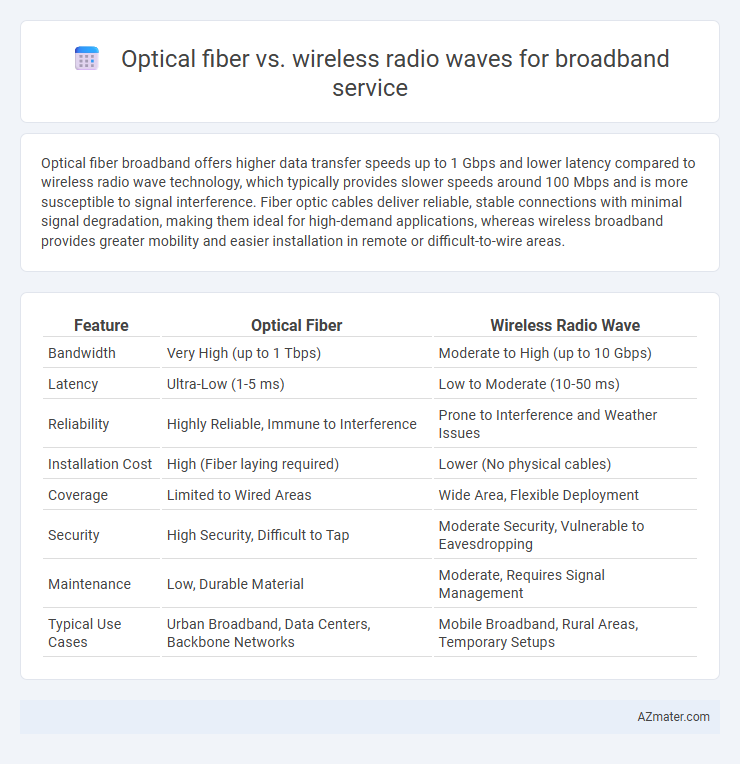Optical fiber broadband offers higher data transfer speeds up to 1 Gbps and lower latency compared to wireless radio wave technology, which typically provides slower speeds around 100 Mbps and is more susceptible to signal interference. Fiber optic cables deliver reliable, stable connections with minimal signal degradation, making them ideal for high-demand applications, whereas wireless broadband provides greater mobility and easier installation in remote or difficult-to-wire areas.
Table of Comparison
| Feature | Optical Fiber | Wireless Radio Wave |
|---|---|---|
| Bandwidth | Very High (up to 1 Tbps) | Moderate to High (up to 10 Gbps) |
| Latency | Ultra-Low (1-5 ms) | Low to Moderate (10-50 ms) |
| Reliability | Highly Reliable, Immune to Interference | Prone to Interference and Weather Issues |
| Installation Cost | High (Fiber laying required) | Lower (No physical cables) |
| Coverage | Limited to Wired Areas | Wide Area, Flexible Deployment |
| Security | High Security, Difficult to Tap | Moderate Security, Vulnerable to Eavesdropping |
| Maintenance | Low, Durable Material | Moderate, Requires Signal Management |
| Typical Use Cases | Urban Broadband, Data Centers, Backbone Networks | Mobile Broadband, Rural Areas, Temporary Setups |
Introduction to Broadband Technologies
Optical fiber offers high-speed broadband with greater bandwidth capacity and low signal attenuation, making it ideal for long-distance and heavy data transmission. Wireless radio wave broadband provides flexible, quick deployment and mobility, suitable for areas lacking physical infrastructure. Both technologies complement each other in modern broadband networks, balancing speed, coverage, and installation costs.
Optical Fiber: An Overview
Optical fiber technology delivers broadband service by transmitting data as light through strands of glass or plastic, offering significantly higher bandwidth and faster speeds compared to wireless radio waves. The low signal attenuation and immunity to electromagnetic interference in optical fibers ensure reliable and consistent data transmission over long distances, making it ideal for backbone and last-mile connectivity. Optical fiber networks support scalable infrastructure advancements, enabling future-proof broadband services with minimal latency and enhanced security.
Wireless Radio Wave: An Overview
Wireless radio wave broadband service utilizes microwave, millimeter-wave, and sub-6 GHz frequencies to deliver high-speed internet connectivity without the need for physical cables. This technology offers greater mobility and faster deployment compared to optical fiber, making it ideal for rural areas, temporary setups, and urban environments with challenging infrastructure. Advances in 5G and Wi-Fi 6 protocols enhance wireless radio wave performance by increasing data rates, reducing latency, and supporting massive device connectivity.
Speed and Bandwidth Comparison
Optical fiber technology delivers significantly higher speed and bandwidth compared to wireless radio wave broadband, with potential speeds reaching up to 1 Gbps or more, while wireless radio waves typically offer speeds between 100 Mbps to 600 Mbps. Optical fiber provides consistent, low-latency connections with massive bandwidth capacity, supporting data-intensive applications and future upgrades without significant infrastructure changes. Wireless radio wave broadband experiences variable speeds and limited bandwidth due to signal interference, distance, and spectrum constraints, making it less suitable for high-demand environments.
Reliability and Signal Stability
Optical fiber broadband offers superior reliability and signal stability compared to wireless radio wave technology due to its immunity to electromagnetic interference and consistent data transmission over long distances. Wireless radio waves are susceptible to environmental factors such as weather conditions, physical obstructions, and signal attenuation, which can cause fluctuations in speed and connectivity. The fiber optic infrastructure provides a more stable and predictable connection, making it the preferred choice for high-demand applications and areas requiring uninterrupted internet service.
Coverage and Accessibility
Optical fiber provides extensive broadband coverage with high-speed, low-latency connections but requires physical infrastructure, limiting accessibility in remote or rugged areas. Wireless radio wave technology offers broader accessibility, especially in hard-to-reach or rural regions, due to its flexibility and ease of deployment, though it may face signal degradation and lower speeds over long distances. Combining both technologies often ensures optimal broadband coverage and accessibility by leveraging fiber's capacity and wireless's reach.
Installation and Maintenance Requirements
Optical fiber installation requires precise trenching or aerial deployment with specialized equipment, demanding higher initial investment and skilled technicians for splicing and connectorization. Wireless radio wave broadband installation involves setting up antennas and base stations with comparatively faster deployment and lower upfront costs, but requires careful site surveys to avoid interference and ensures line-of-sight or optimal signal propagation. Maintenance for optical fiber includes routine inspections for physical damage and signal attenuation, while wireless systems need frequent adjustments for environmental changes, equipment calibration, and potential interference mitigation.
Cost Efficiency Analysis
Optical fiber offers higher cost efficiency for broadband service over the long term due to its lower maintenance expenses and superior bandwidth capacity, enabling scalable data transmission without frequent upgrades. Wireless radio wave technology has lower initial deployment costs but incurs higher ongoing operational expenses from spectrum licensing, interference management, and limited range requiring multiple access points. Investment in fiber optic infrastructure yields better return on investment by reducing latency and energy consumption while supporting exponential data growth demands.
Security and Privacy Concerns
Optical fiber broadband provides enhanced security and privacy due to its resistance to electromagnetic interference and difficulty in signal tapping, reducing risks of data breaches and eavesdropping compared to wireless radio wave technologies. Wireless radio wave broadband is more vulnerable to interception and unauthorized access because signals transmit through open air, making encryption protocols crucial to safeguard user data. Despite stronger physical security with optical fibers, both technologies require robust cybersecurity measures to protect against evolving threats in broadband communications.
Future Prospects and Technology Trends
Optical fiber technology offers unparalleled bandwidth and low latency, making it the foundation for future broadband networks supporting 5G, IoT, and smart cities. Wireless radio wave advancements like mmWave and massive MIMO enhance mobility and coverage but face challenges in signal attenuation and environmental interference. The integration of fiber-optic backhaul with advanced wireless access points represents a key trend driving ultra-fast, reliable broadband infrastructure for next-generation digital ecosystems.

Infographic: Optical fiber vs Wireless radio wave for Broadband service
 azmater.com
azmater.com